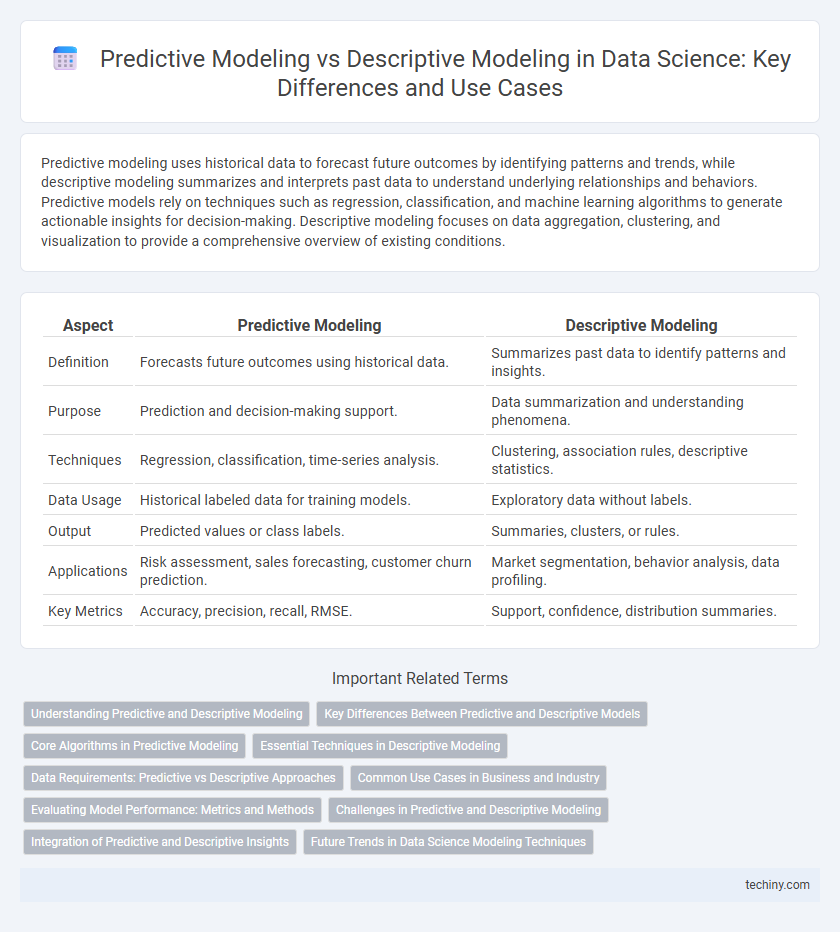Predictive modeling uses historical data to forecast future outcomes by identifying patterns and trends, while descriptive modeling summarizes and interprets past data to understand underlying relationships and behaviors. Predictive models rely on techniques such as regression, classification, and machine learning algorithms to generate actionable insights for decision-making. Descriptive modeling focuses on data aggregation, clustering, and visualization to provide a comprehensive overview of existing conditions.
Table of Comparison
| Aspect | Predictive Modeling | Descriptive Modeling |
|---|---|---|
| Definition | Forecasts future outcomes using historical data. | Summarizes past data to identify patterns and insights. |
| Purpose | Prediction and decision-making support. | Data summarization and understanding phenomena. |
| Techniques | Regression, classification, time-series analysis. | Clustering, association rules, descriptive statistics. |
| Data Usage | Historical labeled data for training models. | Exploratory data without labels. |
| Output | Predicted values or class labels. | Summaries, clusters, or rules. |
| Applications | Risk assessment, sales forecasting, customer churn prediction. | Market segmentation, behavior analysis, data profiling. |
| Key Metrics | Accuracy, precision, recall, RMSE. | Support, confidence, distribution summaries. |
Understanding Predictive and Descriptive Modeling
Predictive modeling utilizes historical data and machine learning algorithms to forecast future outcomes, making it essential in risk assessment, sales forecasting, and customer behavior prediction. Descriptive modeling analyzes past data to uncover patterns, trends, and relationships within datasets, aiding in segmentation, profiling, and performance analysis. Understanding the distinction between predictive and descriptive modeling enhances data-driven decision-making by aligning analytical approaches with specific business objectives.
Key Differences Between Predictive and Descriptive Models
Predictive modeling focuses on forecasting future outcomes by analyzing historical data patterns, using algorithms like regression, decision trees, and neural networks. Descriptive modeling aims to summarize and interpret existing data to identify underlying structures and relationships through methods such as clustering and association rule mining. The key difference lies in their objectives: predictive models estimate unknown future variables, while descriptive models provide insights into current or past data characteristics.
Core Algorithms in Predictive Modeling
Core algorithms in predictive modeling include linear regression, decision trees, random forests, support vector machines, and neural networks, all designed to forecast future outcomes based on input data. These algorithms optimize for accuracy by learning patterns from historical datasets, enabling predictions about unseen data points. Unlike descriptive modeling, which focuses on summarizing past data through clustering and association rules, predictive modeling emphasizes generalization to new data.
Essential Techniques in Descriptive Modeling
Descriptive modeling employs essential techniques such as clustering, association rule mining, and dimensionality reduction to uncover patterns and relationships within historical data. These methods segment data into meaningful groups, identify frequent co-occurrences, and reduce complexity by extracting key features, enabling better understanding of underlying trends. Mastery of these techniques is crucial for generating actionable insights without relying on future outcome predictions.
Data Requirements: Predictive vs Descriptive Approaches
Predictive modeling requires large, high-quality datasets with historical labels to train algorithms that forecast future outcomes accurately. Descriptive modeling depends on comprehensive, well-structured data to identify patterns and summarize past behaviors effectively. Both approaches demand rigorous data preprocessing, but predictive models often need more granular time-series or transactional data for precise predictions.
Common Use Cases in Business and Industry
Predictive modeling is widely used in business for customer churn prediction, sales forecasting, and risk assessment, enabling proactive decision-making based on future outcomes. Descriptive modeling serves industries by analyzing historical data to identify trends, segment customers, and assess operational performance, providing insights into past behavior. Companies leverage predictive models to optimize marketing strategies and improve supply chain efficiency, while descriptive models are essential for reporting and diagnostics.
Evaluating Model Performance: Metrics and Methods
Predictive modeling evaluation commonly relies on metrics like accuracy, precision, recall, F1-score, and ROC-AUC to quantify a model's ability to generalize on unseen data and forecast outcomes accurately. Descriptive modeling focuses on capturing underlying patterns and relationships within the data using metrics such as R-squared, explained variance, and cluster cohesion to assess model interpretability and data summarization quality. Cross-validation, confusion matrices, and residual analysis are essential methods for validating predictive models, while descriptive models often use silhouette scores or factor loadings to evaluate their explanatory power.
Challenges in Predictive and Descriptive Modeling
Predictive modeling faces challenges such as data quality issues, overfitting, and the need for large, representative datasets to ensure accurate future outcomes. Descriptive modeling struggles with capturing complex data patterns and providing actionable insights without oversimplifying or misinterpreting historical data. Both approaches require robust feature selection and continuous validation to maintain model reliability and relevance.
Integration of Predictive and Descriptive Insights
Predictive modeling leverages historical data to forecast future outcomes, while descriptive modeling analyzes past data to identify patterns and trends. Integrating predictive and descriptive insights enhances decision-making by providing a comprehensive understanding of both current states and potential future scenarios. Combining these approaches enables data scientists to develop robust strategies that optimize business performance and risk management.
Future Trends in Data Science Modeling Techniques
Future trends in data science modeling techniques emphasize the integration of predictive modeling with advanced machine learning algorithms such as deep learning and reinforcement learning to enhance accuracy and scalability. Descriptive modeling is increasingly leveraging natural language processing and automated clustering methods to extract actionable insights from unstructured data. Hybrid approaches combining predictive and descriptive models are gaining traction, enabling more comprehensive analytics that support dynamic decision-making in real-time environments.
predictive modeling vs descriptive modeling Infographic

 techiny.com
techiny.com